

Assessment and Academic integrity - LX at UTS. Authentic Assessment: Assessing Student Learning: Teaching Resources: Center for Innovative Teaching and Learning: Indiana University Bloomington. When considering how to assess student learning in a course, most instructors would agree that the ideal assessment would be one that not only assesses students’ learning; it also teaches students and improves their skills and understanding of course content.
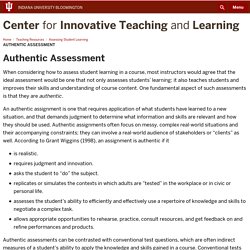
One fundamental aspect of such assessments is that they are authentic. An authentic assignment is one that requires application of what students have learned to a new situation, and that demands judgment to determine what information and skills are relevant and how they should be used. Authentic assignments often focus on messy, complex real-world situations and their accompanying constraints; they can involve a real-world audience of stakeholders or “clients” as well. According to Grant Wiggins (1998), an assignment is authentic if it Authentic assessments can be contrasted with conventional test questions, which are often indirect measures of a student’s ability to apply the knowledge and skills gained in a course. References. The Benefits of Rubrics in Online Classes - Center for Teaching and Learning. Rubrics are an essential tool for any instructor, but they play an even more compelling role in online courses.
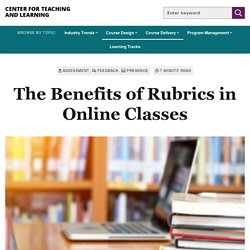
By creating rubrics that describe different levels of student performance, instructors not only make it easier and quicker to grade assignments, but also better communicate expectations, encourage self-assessment, and foster engagement. Authentic Assessment in the Online Classroom - Center for Teaching and Learning. Assessment is a critical component of the online classroom.
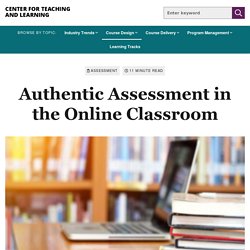
It provides students with an idea of their progress in a course, identifies individual strengths and weaknesses, and ultimately serves as the measure of whether students achieve the course’s learning objectives. Although each of these characteristics serves a valuable instructional or pedagogical function, it’s also important that assessments engage students and prepare them with the skills they’ll need in future courses, practicums, and even their careers. Assessment isn’t just important from a student perspective. With the online marketplace becoming increasingly crowded, it’s critical that institutions ensure they are offering the courses and experiences that students are looking for.
Because the majority of online students are career-focused, courses and degree programs must provide those ties to the real world for institutions to stand out in the online landscape. 60formativeassessment. Techenabled grading Strategies handout. New ways to grade more effectively (essay) Pause a moment to consider the way we’ve been grading our students’ work since time immemorial.

The way we allocate points on the basis of apparent quality. The way we struggle to be fair in giving the same number of points to works of comparable quality, even though they differ a great deal -- and the time it takes us to make these hairsplitting decisions. The way students stress over the points their work does or doesn’t get. The way they challenge our grading decisions in the hope of squeezing more points out of us -- despite the agonizing care and attention to detail we give to their work. For students, it’s all about maximizing partial credit. Consider, too, the value that external stakeholders attach to our grading. Our grading system is broken, yet we educators keep using it. Imagine another grading system, one where you grade all assignments and tests satisfactory/unsatisfactory, pass/fail. Too formulaic? 10 Assessments You Can Perform In 90 Seconds.
10 Assessments You Can Perform In 90 Seconds by TeachThought Staff Good assessment is frequent assessment.
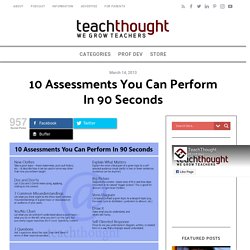
Any assessment is designed to provide a snapshot of student understand—the more snapshots, the more complete the full picture of knowledge. On its best day, an assessment will be 100% effective, telling you exactly what a student understands. More commonly, the return will be significantly lower as the wording of questions, the student’s sense of self-efficacy, or other factors diminish their assessment performance. Classroom Assessment Techniques (CATs) Print Version What Are CATs?
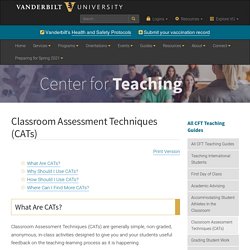
Classroom Assessment Techniques (CATs) are generally simple, non-graded, anonymous, in-class activities designed to give you and your students useful feedback on the teaching-learning process as it is happening. Examples of CATs include the following. The Background Knowledge Probe is a short, simple questionnaire given to students at the start of a course, or before the introduction of a new unit, lesson or topic. It is designed to uncover students’ pre-conceptions.The Minute Paper tests how students are gaining knowledge, or not. Why Should I Use CATs? 34 Assessment Strategies for Each Stage of the Journey [Infographic] When it comes to developing assessment strategies, teachers often ask themselves these three questions: when, why, and most importantly, how?
![34 Assessment Strategies for Each Stage of the Journey [Infographic]](http://cdn.pearltrees.com/s/pic/th/assessment-infographic-161561953)
In the past we’ve talked a lot about the kinds of assessment strategies and activities that not only enhance learning, but help your learners lead their own way. The Sheridan Center for Teaching and Learning. Peer assessment - sometimes also called peer grading, peer evaluation, or peer review - is widely used in teaching both online and in person.
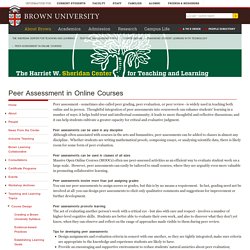
Thoughtful integration of peer assessments into coursework can enhance students' learning in a number of ways: it helps build trust and intellectual community; it leads to more thoughtful and reflective discussions; and it can help students cultivate a greater capacity for critical and evaluative judgment. Peer assessments can be used in any discipline Although often associated with courses in the arts and humanities, peer assessments can be added to classes in almost any discipline. Whether students are writing mathematical proofs, composing essays, or analyzing scientific data, there is likely room for some form of peer evaluation. Peer assessments can be used in classes of all sizes Massive Open Online Courses (MOOCs) often use peer-assessed activities as an efficient way to evaluate student work on a large scale.
One Minute Paper. Rationale for One-Minute Paper The one-minute paper is a simple way of creating feedback in classes where student numbers are large.

The teacher poses some questions to the students on important topics near the end of a lecture, reviews the students' responses after the class and addresses any misunderstandings through feedback in the next class. The feedback directly relates to the students responses and can involve class discussion or even further probing of understanding by the teacher. In responding to the questions students learn what they do not understand and they might discuss this with peers or engage in their own search for answers outside class.
There are many variations on the one-minute paper and it can be used in any discipline to develop understanding or specific skills. Implementing the One-Minute Paper The basic idea is that before a lecture begins students are presented with two questions such as: Variations on this procedure are given by Steve Draper (see reference below) CTE - What Do Students Already Know? Doing so is grounded in learning theories (Ausubel, 1968; Dewey, 1938) and is supported by research on the learning process (Tobias, 1994; Dochy, Segers & Buehl, 1999; Fisher, 2004).
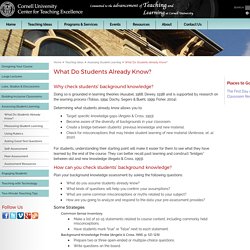
For students, understanding their starting point will make it easier for them to see what they have learned by the end of the course. They can better recall past learning and construct “bridges” between old and new knowledge (Angelo & Cross, 1993). Ambrose, S. A. (2010). How learning works: Seven research-based principles for smart teaching. Angelo, T. & Cross, P. (1993). Ausubel, D., Novak, J, and Hanesian, H. (1968). iTeachU – Content Curation Tools. Content Curation ToolsJennifer Moss2014-05-13T14:38:01+00:00 What is Content Curation? As instructors, we are all information curators. Concept Mapping. Classroom Assessment Techniques (CATs) 50 Classroom Assessment Techniques. 10 Assessments You Can Perform In 90 Seconds.
Using Classroom Assessment Techniques-Teaching Excellence & Educational Innovation. Classroom Assessment Techniques (CATs) are a set of specific activities that instructors can use to quickly gauge students’ comprehension. They are generally used to assess students’ understanding of material in the current course, but with minor modifications they can also be used to gauge students’ knowledge coming into a course or program. CATs are meant to provide immediate feedback about the entire class’s level of understanding, not individual students’. The instructor can use this feedback to inform instruction, such as speeding up or slowing the pace of a lecture or explicitly addressing areas of confusion.